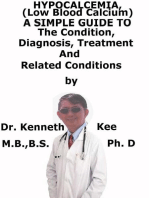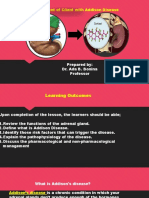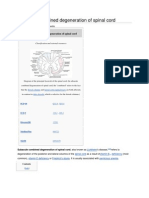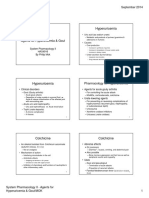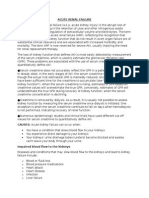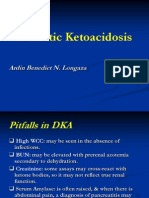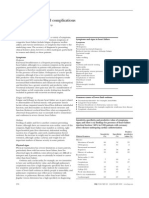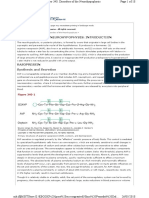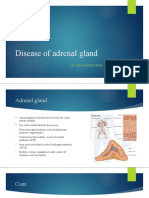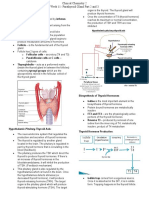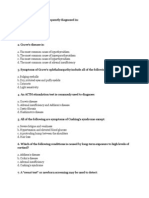Addison Disease: Diagnosis and Initial Management
Addison Disease: Diagnosis and Initial Management
Uploaded by
Teguh RahCopyright:
Available Formats
Addison Disease: Diagnosis and Initial Management
Addison Disease: Diagnosis and Initial Management
Uploaded by
Teguh RahOriginal Description:
Original Title
Copyright
Available Formats
Share this document
Did you find this document useful?
Is this content inappropriate?
Copyright:
Available Formats
Addison Disease: Diagnosis and Initial Management
Addison Disease: Diagnosis and Initial Management
Uploaded by
Teguh RahCopyright:
Available Formats
834 Reprinted from AUSTRALIAN FAMILY PHYSICIAN VOL. 39, NO.
11, NOVEMBER 2010
Background
Adrenal insufficiency is a rare disease caused by either
primary adrenal failure (Addison disease) or by impairment
of the hypothalamic-pituitary-adrenal axis. Steroid
replacement therapy normalises quality of life, however,
adherence can be problematic.
Objective
This article provides information on adrenal insufficiency
focusing on awareness of initial symptoms and on
risk scenarios, emergency management and baseline
investigations, complete investigations and long term
management.
Discussion
Early recognition of adrenal insufficiency is essential
to avoid associated morbidity and mortality. Initial
diagnosis and decision to treat are based on history and
physical examination. Appropriate management includes
emergency resuscitation and steroid administration. Initial
investigations can include sodium, potassium and blood
glucose levels. However, complete investigations can be
deferred. Specialist advice should be obtained and long
term management includes a Team Care Arrangement. For
patients, an emergency plan and emergency identification
are essential.
Keywords: Addison disease; diagnosis, differential;
fludrocortisone; hydrocortisone; patient care planning
Susan OConnell
Aris Siafarikas
Addison disease
Diagnosis and initial management
Primary adrenal insufficiency was first described
by the English physician Thomas Addison in 1855.
1
Addison disease is a rare condition with an estimated
prevalence of 411 per 100 000 and an incidence of 0.8
per 100 000 population/year.
2,3
In children, boys constitute
approximately 75% of patients in contrast to adults, where
the majority (70%) are women.
4
The underlying pathology is
a destruction of the cortex of the adrenal gland.
5
Secretion
of cortisol is reduced or absent, with or without associated
reduction or absence of aldosterone. Adrenocorticotrophic
hormone (ACTH) levels are increased.
2
Historically, tuberculosis was the most common cause of Addison
disease.
4,5
Today however, 7080% of all cases of Addison disease
in the Western world are due to autoimmune adrenalitis;
4,6
whereas
worldwide infectious diseases such as tuberculosis,
7
fungal
infections (histoplasmosis, cryptococcus), and cytomegalovirus are
still important causes. Acute haemorrhage (ie. in meningococcal
septicaemia) although uncommon, is also a cause of primary adrenal
insufficiency.
5
Overall, Addison disease in the paediatric population is most
commonly attributed to primary adrenal insufficiency, which occurs in
approximately one in 15 000 births and usually presents in the neonatal
period or early childhood.
8
Ninety-five percent of cases are due to
deficiency of an enzyme (21 hydroxylase) involved in the steroidogenesis
pathway, which also results in impaired aldosterone synthesis. In
contrast to Addison disease, the adrenal cortex is not destroyed and
hence increased ACTH stimulation causes adrenal hyperplasia.
5
Concomitant autoimmune disease is seen in 50% of patients with
Addison disease. These include thyroid disease, hypoparathyroidism
and type 1 diabetes mellitus.
5
More complex associations can be found
in two recognised polyglandular autoimmune syndromes (PGA).
5,8,9
Secondary forms of adrenal insufficiency, characterised by low
ACTH levels, are caused by hypopituitarism due to pituitary disease,
or suppression of the hypothalamo-pituitary-adrenal axis (HPA)
following steroid therapy or endogenous steroid excess (ie. tumour).
The role of inhaled steroids is controversial. It has been suggested
that therapy with more than 800 g/day over a prolonged period of
time might result in HPA suppression.
10
In secondary adrenal insufficiency, secretion of aldosterone is
not affected. However, with acute hypopituitarism, other hormone
Traps for the unwary
Reprinted from AUSTRALIAN FAMILY PHYSICIAN VOL. 39, NO. 11, NOVEMBER 2010 835
What should I do?
In every scenario the initial diagnosis of acute adrenal insufficiency
and decision to treat are based on history, physical examination, and
occasionally, laboratory findings (hyponatraemia, hyperkalaemia,
hypoglycaemia).
12
Delay in treatment while attempting to confirm
this diagnosis can result in poor outcomes and must be avoided
(Table 1).
13
Management of adrenal crisis
This is a medical emergency.
12,13
Acute management is based
on emergency resuscitation: restoring and maintaining circulation,
administration of IV hydrocortisone, detection and treatment of
hypoglycaemia, and identification and treatment of precipitating
causes. A specialist should be contacted early. In many cases
admission to an intensive care unit will be required.
12,13
Management of the subacute or chronic
presentation
In most cases patients are cardiovascularly stable. Electrolyte
imbalances and hypoglycaemia can be present. Therapy will focus
on steroid replacement and fluid resuscitation. Basic laboratory
investigations include sodium, potassium and blood glucose levels.
Urea, creatinine, calcium and full blood count can be added to
specify underlying causes. Referral to an endocrinologist for further
investigations will be required to confirm primary adrenal insufficiency.
Optional investigations are: serum cortisol, serum ACTH and
24 hour urinary cortisol. If considered necessary, a synacthen (ACTH
stimulation) test can be performed but this should never result in
delayed administration of steroids and should only be performed under
controlled circumstances in the hospital setting.
Education of the patient, and their family, on the diagnosis,
importance of adherence, and an emergency management plan must
be initiated.
Long term management
Long term management may include a Team Care Arrangement
involving a general practitioner, endocrinologist and clinical nurse
specialist. Assistance by social workers and psychologists can be
important. Medical management includes replacement of
cortisol aldosterone. Regular specialist reviews are needed to
optimise therapy.
12,1416
These include: assessment of growth
and pubertal development, looking for clinical signs of adrenal
insufficiency, biochemical analyses of electrolytes, cortisol levels and,
depending on the underlying pathology, ACTH, and monitoring for
other autoimmune conditions.
5
Emphasis will be on the importance
of adherence with medication and adjustments for illness and stress
situations to achieve a good quality of life.
11,13
As steroid replacement
therapy is associated with an increased risk of osteoporosis, further
investigations including dual energy X-ray absorptiometry scans and
preventive strategies such as adequate dietary calcium, exercise and
vitamin D/sun exposure should be considered.
deficiencies including growth hormone, thyroxine, oestradiol or
testosterone, must be identified and treated.
When should I consider an adrenal
crisis?
Adrenal crisis is a medical emergency and should be considered in any
patient presenting with one or more of the following symptoms:
altered consciousness
circulatory collapse
hypoglycaemia
hyponatraemia
hyperkalaemia
seizures
history of steroid use/withdrawal, or
any clinical features of Addison disease.
Adrenal crisis may be precipitated by stress, sepsis, dehydration or
trauma; clinical features may be modified accordingly. In patients with
known adrenal insufficiency, nonadherence with therapy, inappropriate
cortisol dose reduction or lack of stress related cortisol dose
adjustment can cause adrenal crisis.
11
When should I consider Addison
disease?
Addison disease can manifest with adrenal crisis. Chronic symptoms
result from cortisol deficiency, aldosterone deficiency and excess ACTH:
cortisol deficiency results in weakness (99%), fatigue, weight loss
(97%), anorexia progressing to nausea, vomiting, diarrhoea (20%),
constipation (19%), flank or abdominal pain (34%), low blood
glucose levels and hyperthermia.
2,4,5
Fasting hypoglycaemia is
common and occurs because of loss of the gluconeogenic effects of
cortisol.
5
In patients with pre-existing type 1 diabetes, deterioration
of glycaemic control with recurrent hypoglycaemia can be the
presenting sign of adrenal insufficiency
2
aldosterone deficiency causes hyponatraemia, hyperkalaemia,
acidosis, tachycardia and hypotension. Low voltage
electrocardiogram (ECG) and a small heart on chest X-ray are
not necessarily present.
4,5
Suggestive symptoms are postural
hypotension and salt cravings
2,11
excess ACTH is only present in primary adrenal insufficiency. It
causes increased melanin production resulting in generalised
hyperpigmentation.
4,5
Because this resembles a suntan, it is
essential to inspect areas not exposed to the sun for diffuse
hyperpigmentation which can be more obvious in recent scars
and in areas such as the axillae, nipples, pressure points,
palmar creases, and mucous membranes. Some patients with
autoimmune mediated adrenal insufficiency also present with
vitiligo.
2,5
Chronic unrecognised Addison disease can cause psychiatric symptoms
such as memory impairment, confusion, apathy, depression and
psychosis.
5
These features regress on treatment with replacement
corticosteroids.
FOCUS
836 Reprinted from AUSTRALIAN FAMILY PHYSICIAN VOL. 39, NO. 11, NOVEMBER 2010
Addison disease diagnosis and initial management
5.5 mmol/L. He was given a bolus of 10% dextrose followed
by normal saline. He then had a generalised tonic clonic
seizure, was treated with anticonvulsants and intubated,
ventilated and transferred to the intensive care unit.
In his background history he had an admission at 11 months
of age with profound hypoglycaemia (BGL 0.6 mmol/L)
following an episode of gastroenteritis. He had presented to
the ED unresponsive and pale following 18 hours of profuse,
watery diarrhoea and vomiting. At that time, sodium was
recorded at 126 mmol/L with potassium 4.3 mmol/L. He
became alert and interactive after 10% dextrose bolus.
On the second admission, the boy was noted to have
hyperpigmentation of the buccal mucosa (Figure 1) and
appeared diffusely suntanned.
Plasma cortisol was <30 mmol/L with a raised ACTH of
492 pmol/L (normal range 2.010). A diagnosis of acute
Addisonian crisis was made and he was treated with 50 mg
IV hydrocortisone 4 hourly. He made a full recovery.
He was discharged on oral maintenance hydrocortisone
with an emergency plan. A MedicAlert bracelet and
ambulance cover were organised. Further investigations
revealed normal aldosterone levels, negative adrenal
Emergency plan
An up-to-date emergency plan and practical teaching in administering
emergency medication are of paramount importance. At each
consultation the physician must ensure that the patient and carer(s)
are well versed in the emergency plan and that their ready-to-use vial
of emergency hydrocortisone is in-date and available for use at any
time.
11,14
In growing children, the dose may require adjustment and a
new appropriate prescription should be issued where indicated. It is
recommended that patients wear a MedicAlert bracelet or pendant and
have ambulance cover.
Case study 1 An acute presentation
Paramedics attended a boy, aged 21 months, at his home. His
Glasgow Coma Scale was 8/15. He was poorly perfused, with
Sp0
2
of 76% and capillary blood glucose <2 mmol/L. He had
been unwell at home with symptoms of an upper respiratory
tract infection for the previous 24 hours. He was given oral
glucose gel and IM glucagon with no effect. On arrival at
the hospital emergency department he had spontaneous
respirations with a heart rate of 126 bpm and cool peripheries.
Investigations showed a metabolic acidosis, blood glucose
level (BGL) of 1.6 mmol/L, sodium 134 mmol/L and potassium
Table 1. Summary of the management and prevention of acute adrenal insufciency
5,11,14
Clinical findings
Cortisol deficiency: weakness, anorexia, nausea
and/or vomiting, hypoglycaemia, hypotension
(particularly postural) and shock
Aldosterone deficiency: dehydration, hyperkalaemia,
hyponatraemia, acidosis, low blood pressure
Investigations
Blood sugar level; serum glucose, urea, sodium and
potassium; blood gas analysis
Keep extra blood for analysis of ACTH and cortisol
if possible
Do not wait for results to start therapy
Intravenous fluids
Initial fluid resuscitation: NaCl 0.9% 20 mL/kg (severe
dehydration); 10 mL/kg (moderate dehydration)
repeat until circulation restored
Maintenance fluids: 510% dextrose
Steroid replacement (hydrocortisone)
If intravenous (IV) access is difficult, give
intramuscularly (IM) while establishing IV line
Neonates (1 year): 25 mg stat, then 1025 mg
46 hourly
Toddlers (13 years): 2550 mg stat, then 2550 mg
46 hourly
Children (412 years): 5075 mg stat, then 5075 mg
46 hourly
Adolescents and adults: 100150 mg stat, then 100 mg
46 hourly
Correction of hypoglycaemia
Neonates or infants: 10% dextrose 5 mL/kg (IV bolus)
Older children, adolescents and adults: 25% dextrose
2 mL/kg (IV bolus)
Correction of hyperkalaemia
Potassium usually normalises with fluid and electrolyte
replacement
If K+ >6 mmol/L perform ECG and apply cardiac monitor
as arrhythmias and cardiac arrest may occur
Identify and treat potential precipitating causes
Admit to appropriate inpatient facility
When patient tolerates oral intake
Reduce IV hyrocortisone dose, then switch to triple
dose oral hydrocortisone therapy, gradually reducing to
maintenance levels (1015 mg/m
2
/day)
Patients with aldosterone deficiency: start fludrocortisone
at maintenance doses (usually 0.1 mg/day)
11
Prevention
Emergency plan for susceptible patients, emergency
identification (MedicAlert)
Triple normal oral maintenance dose for 23 days during
stress (ie. fever, fracture)
Administer IM hydrocortisone if oral medication not
tolerated (eg. vomiting)
Increase parenteral hydrocortisone (12 mg/kg) before
anaesthesia, consider increased dose postoperatively
Ensure patients have ambulance cover and ready-to-use
IM hydrocortisone preparation (Act-o-vial
) for emergencies
FOCUS
Reprinted from AUSTRALIAN FAMILY PHYSICIAN VOL. 39, NO. 11, NOVEMBER 2010 837
Addison disease diagnosis and initial management
Why is Addison disease easily missed?
Addison disease is easily missed due to nonspecific symptoms and
presentations, rarity of the condition, and low index of suspicion.
The consequences of delayed diagnosis and treatment are increased
morbidity, mortality and medicolegal risk.
12,13
Outcomes may be
improved with a higher index of diagnostic suspicion, prompt emergency
management with IM or IV hydrocortisone as indicated, early referral,
and good patient education.
11,13
Key points in management
Physical findings are subtle and nonspecific; hyperpigmentation
may be seen, particularly in sun exposed areas or pressure points.
Circulatory compromise can range from mild signs of sodium and
volume depletion to shock.
If in doubt give oral/IM/IV hydrocortisone.
Dont delay treatment while awaiting laboratory results.
Authors
Susan OConnell MB, MRCPI, MD, is Fellow in Paediatric
Endocrinology, Princess Margaret Hospital for Children, Western
Australia. susanmary.oconnell@health.wa.gov.au
Aris Siafarikas MD, FRACP, is Consultant Paediatric Endocrinologist,
Princess Margaret Hospital for Children, Clinical Associate Professor,
Institute of Health and Rehabilitation Research, University of Notre
Dame, and Senior Clinical Lecturer, School of Paediatrics and Child
Health, University of Western Australia, Perth, Western Australia.
Conflict of interest: none declared.
References
1. Addison T, editor. On the constitutional and local effects of disease of the supra-
renal capsules. London: Highley, 1855.
2. Arlt W, Allolio B. Adrenal insufficiency. Lancet 2003;361:188193.
3. Laureti S, Vecchi L, Santeusanio F, et al. Is the prevalence of Addisons disease
underestimated? J Clin Endocrinol Metab 1999;84:1762.
4. Brook GD, Brown RS, editors. Handbook of clinical pediatric endocrinology. 1st
edn. Malden, Mass: Blackwell Publishing, 2008.
5. Kronenburg, editor. Williams textbook of endocrinology. 11th edn. Philadelphia:
Saunders Elsevier, 2008.
6. Oelkers W. Adrenal insufficiency. N Engl J Med 1996;335:120612.
7. Soule S. Addisons disease in Africa a teaching hospital experience. Clin
Endocrinol (Oxf) 1999;50:11520.
8. Perry R, Kecha O, Paquette J, et al. Primary adrenal insufficiency in children:
twenty years experience at the Sainte-Justine Hospital, Montreal. J Clin
Endocrinol Metab 2005;90:324350.
9. Ahonen P, Myllarniemi S, Sipila I, et al. Clinical variation of autoimmune
polyendocrinopathy-candidiasis-ectodermal dystrophy (APECED) in a series of 68
patients. N Engl J Med 1990;322:182936.
10. Greenfield JR, Samaras K. Suppression of HPA axis in adults taking inhaled corti-
costeroids. Thorax 2006;61:2723.
11. Arlt W. The approach to the adult with newly diagnosed adrenal insufficiency. J
Clin Endocrinol Metab 2009;94:105967.
12. Klauer KM. Adrenal insufficiency and adrenal crisis: differential diagnoses and
workup, 2009. Available at http://emedicine.medscape.com/article/765753-
diagnosis [Accessed 21 October 2010].
13. Erichsen MM, Lovas K, Fougner KJ, et al. Normal overall mortality rate in
Addisons disease, but young patients are at risk of premature death. Eur J
Endocrinol 2009;160:2337.
14. The Royal Childrens Hospital Melbourne. Adrenal crisis. 2010. Available at
www.rch.org.au/clinicalguide/cpg.cfm?doc_id=5121 [Accessed 24 June 2010].
15. Nieman L. Patient information: adrenal insufficiency (Addisons disease).
UpToDate, (internet serial), 2010.
16. Grant DB, Barnes ND, Moncrieff MW, et al. Clinical presentation, growth, and
pubertal development in Addisons disease. Arch Dis Child 1985;60:9258.
antibodies and normal, very long chain fatty acids (to
exclude adrenoleukodystrophy). Investigations to exclude
other endocrinopathies were normal, and no cause for
Addison disease identified.
Ongoing management
Ongoing management in this boy includes oral
hydrocortisone maintenance treatment and growth
monitoring. An emergency plan with instructions to increase
his dose of hydrocortisone in the event of illness is in place.
In the event of unresponsiveness or persistent vomiting his
parents have been instructed on the administration of IM
hydrocortisone and to call the emergency numbers listed
on the emergency plan. The importance of adherence with
regular medications is reiterated and the boys emergency
plan reviewed at each clinic attendance.
Case study 2 Issues in management
A girl, 15 years of age, with a diagnosis of Addison disease
made 3 years previously (anti-adrenal antibodies positive)
attended her routine endocrinology clinic appointment with
her father. She had a history of poor adherence. Regular
medications were: prednisolone 4 mg morning and evening
and fludrocortisone 100 g/day. She denied missing her
medications. She had regular menses. She described fair
energy levels.
On examination she looked well but appeared diffusely
suntanned, not confined to, but more obvious in sun
exposed areas. Her BP was normal. Records showed that
she had not gained weight for the past year.
The patient was intermittently living between her parents
homes. On review of her emergency plan she was unsure
of what to do should she become unwell. Her father
appeared to be well informed in the management of any
illness, however it was revealed that the ready-to-use IM
hydrocortisone was only available at her mothers house.
New prescriptions for IM hydrocortisone were issued for
both homes and for school, and copies of the emergency
plan were also made. The importance of adherence with
regular medication was reiterated.
Figure 1. Hyperpigmentation of the buccal mucosa
You might also like
- Medicine Alaa Notes (All Files Merged) - Best Pro Choice-.Pdf-1Document120 pagesMedicine Alaa Notes (All Files Merged) - Best Pro Choice-.Pdf-1maimoona suleman86% (7)
- SCIENCE-REPORT-GROUP-2.pdf 20240211 212133 0000Document48 pagesSCIENCE-REPORT-GROUP-2.pdf 20240211 212133 0000taishishirogane100% (1)
- BioSci 101 - Lab 5Document2 pagesBioSci 101 - Lab 5qwwqwwqwqwwqwwqNo ratings yet
- Case 16 QuestionsDocument10 pagesCase 16 Questionsapi-532124328No ratings yet
- Internal Medicine (Ans) - M3 Question BankDocument15 pagesInternal Medicine (Ans) - M3 Question BankWu YanlongNo ratings yet
- AlzheimerDocument11 pagesAlzheimerSoniya G08No ratings yet
- Periodontal Disease and DiabetesDocument12 pagesPeriodontal Disease and DiabetesDiana CMNo ratings yet
- Sodium, and 350-500 Meq/L of Chloride. The Combined Effects of Serum Hyperosmolarity, Dehydration, and Acidosis Result in Increased Osmolarity in Brain Cells That ClinicallyDocument5 pagesSodium, and 350-500 Meq/L of Chloride. The Combined Effects of Serum Hyperosmolarity, Dehydration, and Acidosis Result in Increased Osmolarity in Brain Cells That ClinicallyMorgan Mitchell100% (10)
- Diabetic Ketoacidosis Hypoglycemia: DR MD Mamunul Abedin ShimulDocument18 pagesDiabetic Ketoacidosis Hypoglycemia: DR MD Mamunul Abedin ShimulDr. Mamunul AbedinNo ratings yet
- Ibs (Conceptmap)Document4 pagesIbs (Conceptmap)Carly Beth Caparida LangerasNo ratings yet
- Endocrine DisordersDocument5 pagesEndocrine DisordersBilly Ray VillanuevaNo ratings yet
- Systemic Response To Injury and Metabolic SupportDocument118 pagesSystemic Response To Injury and Metabolic SupportNicole DeverasNo ratings yet
- CardioVascular and Endocrin ExercisesDocument6 pagesCardioVascular and Endocrin ExercisesBogartNo ratings yet
- Diagnostic MedlabDocument585 pagesDiagnostic MedlabKiko KiwiblokeNo ratings yet
- Hypocalcemia, (Low Blood Calcium) A Simple Guide To The Condition, Diagnosis, Treatment And Related ConditionsFrom EverandHypocalcemia, (Low Blood Calcium) A Simple Guide To The Condition, Diagnosis, Treatment And Related ConditionsNo ratings yet
- Manuscript Case Report Addison's Disease Due To Tuberculosis FinalDocument22 pagesManuscript Case Report Addison's Disease Due To Tuberculosis FinalElisabeth PermatasariNo ratings yet
- HYPOKALEMIADocument44 pagesHYPOKALEMIARuby Grace QuintoNo ratings yet
- Diabetes: Causes, Symptoms and TreatmentsDocument4 pagesDiabetes: Causes, Symptoms and TreatmentsAbdullah BazryNo ratings yet
- Pituitary Gland: The Hormones and Their Function Presented By: Gufran Bulbul Rono Ciit IslamabadDocument16 pagesPituitary Gland: The Hormones and Their Function Presented By: Gufran Bulbul Rono Ciit IslamabadGufran Gb RonoNo ratings yet
- NCM116 Addison DiseaseDocument20 pagesNCM116 Addison DiseaseSofia MikaelaNo ratings yet
- Anemia-Careplan For AdultDocument29 pagesAnemia-Careplan For AdultdjbhetaNo ratings yet
- Subacute Combined Degeneration of Spinal CordDocument4 pagesSubacute Combined Degeneration of Spinal CordPriyanka MathurNo ratings yet
- NCM 116 Skills - Midterm NotesDocument20 pagesNCM 116 Skills - Midterm NotesmareginaNo ratings yet
- Pituitary GlandDocument30 pagesPituitary GlandAnurag MahawarNo ratings yet
- Myocardialinfarction 150223043527 Conversion Gate02 PDFDocument22 pagesMyocardialinfarction 150223043527 Conversion Gate02 PDFBhavika Aggarwal100% (1)
- Morning Report: Jawaria K. Alam, MD/PGY3Document20 pagesMorning Report: Jawaria K. Alam, MD/PGY3Emily EresumaNo ratings yet
- Multiple SclerosisDocument6 pagesMultiple SclerosisRonnel Alvin Antonio AdrianoNo ratings yet
- Client Information Sheet (CIS)Document10 pagesClient Information Sheet (CIS)Christine RombawaNo ratings yet
- Acute DiarrheaDocument22 pagesAcute DiarrheaRifky Octavio PNo ratings yet
- © 2022 Lippincott Advisor - Diseases and Conditions - HypoglycemiaDocument9 pages© 2022 Lippincott Advisor - Diseases and Conditions - HypoglycemiaBaebee LouNo ratings yet
- Path Endocrine OutlineDocument46 pagesPath Endocrine Outlineaya derweshNo ratings yet
- 4.1agents For Hyperuricemia GoutDocument4 pages4.1agents For Hyperuricemia GoutjohntrueNo ratings yet
- Diabetes MellitusDocument15 pagesDiabetes Mellitusfayeniwa100% (1)
- 4,5 - Diabetes MellitusDocument22 pages4,5 - Diabetes MellitusA A D H I100% (1)
- 1 Management of Hyperkalemia in CKD PatientsDocument49 pages1 Management of Hyperkalemia in CKD PatientsTelli KoromaNo ratings yet
- Sickle Cell Disease: Click To Edit Master Subtitle StyleDocument13 pagesSickle Cell Disease: Click To Edit Master Subtitle StyleAditya Rangga Fandiarta100% (1)
- Endocrine Med-Surg Slide Show Presentation (Nursing)Document43 pagesEndocrine Med-Surg Slide Show Presentation (Nursing)loveoverprideNo ratings yet
- Myocardial Infarction: Ericka Jane S. Barrios, R.NDocument55 pagesMyocardial Infarction: Ericka Jane S. Barrios, R.NdantefuerteNo ratings yet
- Cirrhosis of The Liver: Handout and Information SheetDocument3 pagesCirrhosis of The Liver: Handout and Information SheetRobert G. Gish, MDNo ratings yet
- Description: Kawasaki Disease (Mucocutaneous Lymph Node Syndrome) Is A Form of VasculitisDocument4 pagesDescription: Kawasaki Disease (Mucocutaneous Lymph Node Syndrome) Is A Form of VasculitishamporkNo ratings yet
- Case Study On AsthmaDocument3 pagesCase Study On AsthmaNurudeen Ibrahim100% (1)
- Gout N Osteoporasis GaganDocument33 pagesGout N Osteoporasis GaganGaganpreet Kaur0% (1)
- Communicable Disease ChartDocument1 pageCommunicable Disease ChartArlan AbraganNo ratings yet
- Acute Kidney Injury For NAUTHDocument39 pagesAcute Kidney Injury For NAUTHfranklin ifioraNo ratings yet
- Diabetes Mellitus Part IIDocument12 pagesDiabetes Mellitus Part IIVictoria ArcaNo ratings yet
- KNH 411 - Case Study 22Document17 pagesKNH 411 - Case Study 22api-301118772100% (3)
- Addison's DiseaseDocument4 pagesAddison's DiseasedrtpkNo ratings yet
- Acute Renal Failure StudyDocument4 pagesAcute Renal Failure StudyElyne BicaldoNo ratings yet
- Pernicious Anemia - MitchDocument18 pagesPernicious Anemia - Mitchthalafuj100% (1)
- Schematic Diagram of CKD Sec. To DM Nephropathy, DM Type 2, DM FootDocument8 pagesSchematic Diagram of CKD Sec. To DM Nephropathy, DM Type 2, DM Footbeuwolfagate50% (2)
- Diabetic KetoacidosisDocument13 pagesDiabetic KetoacidosisMabelle Blancada ConsultaNo ratings yet
- Arf NotesDocument28 pagesArf NotesEllen Hennings100% (1)
- Diabetes Type 2 HassanDocument26 pagesDiabetes Type 2 Hassanyash_acharya007100% (1)
- 128 Diabetic KetoacidosisDocument9 pages128 Diabetic KetoacidosisDite Bayu NugrohoNo ratings yet
- Nephrotic Syndrome in Children: January 2013Document7 pagesNephrotic Syndrome in Children: January 2013molenNo ratings yet
- Clinical Features and Complications: ABC of Heart FailureDocument4 pagesClinical Features and Complications: ABC of Heart FailureMohammed Ali Haydar JafferiNo ratings yet
- Concept MapDocument9 pagesConcept MapAllene PaderangaNo ratings yet
- ASN 11 Handout Case Study PDFDocument4 pagesASN 11 Handout Case Study PDFania ojedaNo ratings yet
- Lupus Case ReportDocument1 pageLupus Case ReportMendy HararyNo ratings yet
- SIADH, DI, Cerebral Salt WastingDocument20 pagesSIADH, DI, Cerebral Salt Wastingmaged_najehNo ratings yet
- Genitourinary SystemDocument27 pagesGenitourinary SystemDanica FrancoNo ratings yet
- EndocrineDocument2 pagesEndocrineUnclePorkchopNo ratings yet
- Hereditary Spherocytosis, A Simple Guide To The Condition, Diagnosis, Treatment And Related ConditionsFrom EverandHereditary Spherocytosis, A Simple Guide To The Condition, Diagnosis, Treatment And Related ConditionsNo ratings yet
- Addison Disease: Diagnosis and Initial ManagementDocument5 pagesAddison Disease: Diagnosis and Initial ManagementI Gede SubagiaNo ratings yet
- Diabetes Insipidus HarrisonDocument18 pagesDiabetes Insipidus HarrisonAlmas TNo ratings yet
- Adrenal DisordersDocument32 pagesAdrenal DisordersJyoti ChadhaNo ratings yet
- Summery of Htma Theresa - VernonDocument5 pagesSummery of Htma Theresa - Vernonsisi marxNo ratings yet
- Adrenal Gland Disorders PDFDocument12 pagesAdrenal Gland Disorders PDFChikezie OnwukweNo ratings yet
- Disease of Adrenal GlandDocument47 pagesDisease of Adrenal GlandgibreilNo ratings yet
- Addisonian Crisis: Manish K Medical Officer IgmhDocument47 pagesAddisonian Crisis: Manish K Medical Officer IgmhNaaz Delhiwale100% (1)
- Peds Shelf NotesDocument74 pagesPeds Shelf NotesRandy BornmannNo ratings yet
- Glucocorticoid Withdrawal - UpToDateDocument7 pagesGlucocorticoid Withdrawal - UpToDateGiancarlos GuzmanNo ratings yet
- COVID-19 Vaccine AstraZeneca Analysis PrintDocument103 pagesCOVID-19 Vaccine AstraZeneca Analysis Printmoss4uNo ratings yet
- Week 11 Endocrinology Part 2 3Document12 pagesWeek 11 Endocrinology Part 2 3Toff GoyenecheaNo ratings yet
- Adrenal Gland DisordersDocument79 pagesAdrenal Gland DisordersMohammed Ahmed BamashmosNo ratings yet
- TriamcinoloneDocument5 pagesTriamcinoloneapi-3797941No ratings yet
- Adrenal Disorders in ChildrenDocument39 pagesAdrenal Disorders in ChildrenCorina OngNo ratings yet
- PBL Endocrine and Metabolisme SystemDocument33 pagesPBL Endocrine and Metabolisme Systemthenightstar_03No ratings yet
- Medical Emergencies: Oral & Maxillofacial Surgery 1Document7 pagesMedical Emergencies: Oral & Maxillofacial Surgery 1drpnnreddyNo ratings yet
- Nlex For Endocrine SystemDocument6 pagesNlex For Endocrine SystemRoanne LaguaNo ratings yet
- Anatomy and Physiology of Animals Part 1: EmbryologyDocument7 pagesAnatomy and Physiology of Animals Part 1: EmbryologyJoan BengegNo ratings yet
- Endocrine Disorders PDFDocument55 pagesEndocrine Disorders PDFAkram HusseinNo ratings yet
- Endocrine Practice TestDocument50 pagesEndocrine Practice TestMonemah Essa Francisco Martinez86% (7)
- Adrenocortical AgentsDocument14 pagesAdrenocortical AgentsFredie O HadjimudinNo ratings yet
- MCQ Pathology - EndocineDocument32 pagesMCQ Pathology - Endocineshamseer88% (8)
- (Ebooks PDF) Download Handbook of Diagnostic Endocrinology 3rd Edition William E. Winter Full ChaptersDocument49 pages(Ebooks PDF) Download Handbook of Diagnostic Endocrinology 3rd Edition William E. Winter Full Chaptersshatinrykarl8No ratings yet
- ENDODocument9 pagesENDOJohn denver FloresNo ratings yet
- Adrenal GlandsDocument116 pagesAdrenal GlandsBrandon AreteNo ratings yet
- Your Online Nursing Notes : Addison'S Disease Basic InfoDocument4 pagesYour Online Nursing Notes : Addison'S Disease Basic InfoseigelysticNo ratings yet















